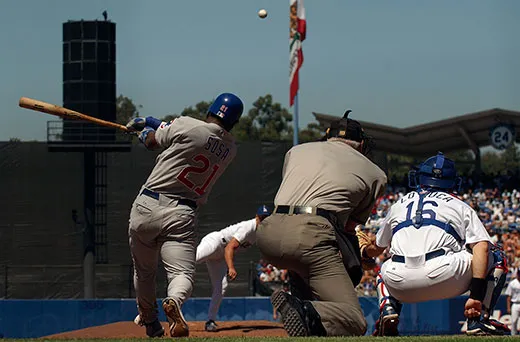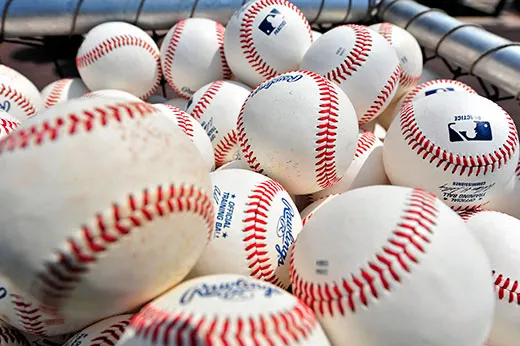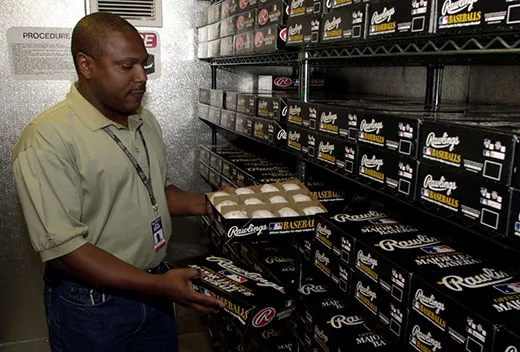The Physics of Cheating in Baseball
Corked bats and juiced balls have long plagued baseball, but do they really help a player’s game? Four scientists found surprising answers
/https://tf-cmsv2-smithsonianmag-media.s3.amazonaws.com/filer/baseball-physics-balls-631.jpg)
Cheating in sports might be as old as the race between the tortoise and the hare. But not all trickery actually works, especially in baseball.
A corked bat can hit the ball farther, right? That’s a myth, say physicists studying the national pastime. And can making a baseball moister really thwart a slugger from putting one in the bleachers? Well, maybe—depending on how hot it is outside.
To separate fact from fiction, four scientists from three universities spent days firing baseballs at bats. The results are published in “Corked Bats, Juiced Balls, and Humidors: The Physics of Cheating in Baseball” in the June issue of the American Journal of Physics.
To Cork or Not to Cork
In June 2003, Chicago Cubs slugger Sammy Sosa was caught using an illegal corked bat—hardly the first time it’s happened in the Major Leagues. A corked bat is one in which a cavity is drilled out of the barrel and filled with a lightweight material such as cork.
It was scandalous…but does it work? That’s the question that intrigued Alan Nathan, a professor emeritus of physics at the University of Illinois (and a die-hard Red Sox fan). “There was some anecdotal information from players that there’s something like a ‘trampoline effect’ when the ball bounces off a corked bat,” says Nathan, one of the authors of the new study. So the researchers hollowed out a bat, stuffed it with bits of cork and fired a ball at the bat from a cannon. If anything, the ball came off the corked bat with a slower speed than off a normal bat. Less velocity means a shorter hit. Their conclusion: the trampoline effect was bogus.
But there was another way corking might work: a corked bat is a few ounces lighter than an unadulterated one, and a lighter bat means a batter can swing faster, which means he can generate more force and hit the ball farther. Right?
Not quite, as it turns out.
A batter indeed can swing a lighter bat faster, but a lighter bat has less inertia. So there’s a trade-off, says Lloyd Smith, an associate professor of engineering at Washington State University and a co-author on the paper. By once again firing a ball at a bat at WSU’s Sports Science Laboratory, the researchers found that a heavier bat still hit the ball harder (and therefore farther) than a lighter, corked bat. “Corking will not help you hit the ball farther,” says Smith.
“That’s not to say that baseball players are dumb,” Smith is quick to add. Players may have another reason to cork their bats: to make the bats lighter so players can, in baseball argot, “get around on a pitch” quicker, allowing them to wait a split second longer before swinging, which gives them more time to judge a ball’s path and to make adjustments during the swing. “So, while corking may not allow a batter to hit the ball farther, it may well allow a batter to hit the ball solidly more often,” the researchers write.
Smith summarizes it this way: “If your goal is to hit more home runs, you should have a heavy bat. If your goal is to have a higher batting average, you should have a lighter bat.”
Keith Koenig, a professor of aerospace engineering at Mississippi State University and a fellow baseball researcher, trusts the paper’s results but cautions that a bat-swinging machine can never fully predict what might actually happen out on the diamond when real batters swing bats. “If we allow corked bats in the Major Leagues, would there be more home runs?” Koenig muses. “That’s the kind of question that can’t be answered just from lab tests.”
Good Hitters—or a Juiced Baseball?
Every few years, during the month of April, Nathan says, batters start hitting home runs and the cry goes up: The baseball isn’t what it used to be! It must be juiced! (Why always in April? “Because in April there’s not enough data to be statistically significant…and people start to speculate,” Nathan says wryly.) The issue of juiced balls surfaced again in 2000 when the first two months of the season saw home runs hit at a notably higher rate than the same period the previous year.
To test the speculation that something had changed with the balls, the researchers compared the bounciness of balls from 2004 with a box of unused balls from 1976 to 1980. They shot the balls at a steel plate or a wooden bat at 60, 90, and 120 miles per hour and measured their bounciness after a collision—what physicists call the coefficient of restitution.
The result? “There was no evidence that there was any difference in the coefficient of restitution of the different balls,” says Nathan. One caveat: the scientists can’t say that balls made in other years aren’t livelier.
How times change, though: these days we’d more likely attribute a rash of home-run slugging to performance-enhancing drugs, not the ball.
The Humidor: Not Just for Cigars Anymore
Coors Field, home of the Colorado Rockies in mile-high Denver, is a pitcher’s nightmare and a batter’s nirvana. The air is only 80 percent as dense as air at sea level, and because there’s less air resistance, balls fly farther and pitches cannot curve as much. That means more hits and more home runs. For the first seven seasons at Coors Field, there were 3.2 home runs per game, compared with 1.93 home runs at the Rockies’ away games.
To try to discourage the mile-high bonanza, in 2002 the Rockies started storing game balls in a humidor that kept the balls at a constant 70 degrees Fahrenheit and 50 percent relative humidity instead of Denver’s typical 30 percent humidity. The idea was that higher humidity reduces the bounciness of the ball and slightly increases its weight. Indeed, the average number of home runs at Coors Field dropped 25 percent from 2002 through 2010.
But is the humidor really to thank (or blame) for the decrease in home runs?
To test the theory, the authors placed several dozen balls in conditions ranging from 11 percent to 97 percent relative humidity for weeks, and temperatures from the 30s to nearly 100 degrees, then fired them against metal cylinders that approximate bats. Again measuring the coefficient of restitution, they found that the colder and moister a ball was, the less bounce it had. Translation: a ball hit on a hot dry day at an Arizona ballpark will go noticeably farther than the same ball hit on a frigid, foggy day at Boston’s Fenway Park.
As for Denver’s Coors Field, the researchers calculate that a humidity increase from 30 percent to 50 percent would take 14 feet off a 380-foot fly ball—enough to decrease the chances of a home run by 25 percent.
Not long ago, Nathan says, a reporter in Arizona contacted him and told him that the Arizona Diamondbacks were considering installing a humidor at their stadium, too. Nathan did the math—this time starting at the desert-air base-line of 20 percent relative humidity, and conditioning balls to 50 percent relative humidity. “That would be an even greater reduction in the number of home runs, more like 37 percent,” he says.
The Diamondbacks later put those plans on hold. Everybody, it seems, likes at least a few homers between their peanuts and Cracker Jack.
Christopher Solomon is a writer in Seattle. In Little League, coaches usually stuck him in right field.



